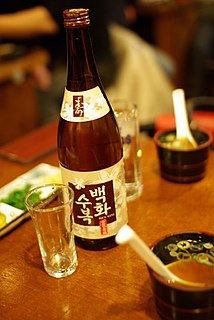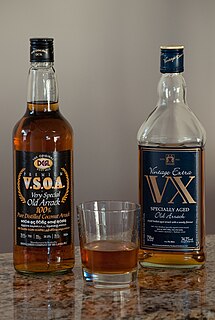
Moonshine was originally a slang term for high-proof distilled spirits that were usually produced illicitly, without government authorization. In recent years, however, moonshine has been legalized in various countries and has become a commercial product.

A pot still is a type of distillation apparatus or still used to distill alcoholic spirits such as whisky or cognac. Pot stills operate on a batch distillation basis. Traditionally constructed from copper, pot stills are made in a range of shapes and sizes depending on the quantity and style of spirit desired.

Rice wine is an alcoholic beverage fermented and distilled from rice, traditionally consumed in East Asia, Southeast Asia and South Asia. Rice wine is made from the fermentation of rice starch that has been converted to sugars. Microbes are the source of the enzymes that convert the starches to sugar.

Arrack is a distilled alcoholic drink typically produced in the Indian subcontinent and Southeast Asia, made from the fermented sap of coconut flowers or sugarcane, and also with grain or fruit depending upon the country of origin. It is sometimes sometimes spelt arak, or simply referred to as 'rack or 'rak. There are two primary styles that are very different: Batavia Arrack is often clear in color but has a flavor profile more similar to dark rum, with a distinctive "funk" or "hogo" imparted to it from fermented red rice. Ceylon Arrack, by contrast, is a more refined and subtle spirit. It has hints of Cognac and rum character and a wealth of delicate floral notes. Both styles are also made "in house" by local citizenry and can be more akin to moonshine in their presentation.

Most distilled spirits that are labelled as "whisky" in India are a form of Indian-made foreign liquor, commonly blends based on neutral spirits that are distilled from fermented molasses with only a small portion consisting of traditional malt whisky, usually about 10 to 12 percent. Outside India, such a drink would more likely be labelled a rum. According to the Scotch Whisky Association's 2013 annual report, unlike the European Union (EU), "there is no compulsory definition of whisky in India, and the Indian voluntary standard does not require whisky to be distilled from cereals or to be matured. Very little Indian 'whisky' qualifies as whisky in the EU owing to the use of molasses or neutral alcohol, limited maturation and the use of flavourings. Such spirits are, of course, considerably cheaper to produce than genuine whisky." Such molasses-based blends make up 90 percent of the spirits consumed as "whisky" in India, although whisky wholly distilled from malt and other grains, is also manufactured and sold.
Indian-made foreign liquor (IMFL) is the official term used by governments, businesses and media in India to refer to all types of hard liquor manufactured in the country other than indigenous alcoholic beverages such as fenny, toddy, arrack and others.
Tharra is a type of Desi daru which is locally, and often illegally, brewed alcoholic drink in North India and Pakistan. It is made from yeast fermentation of sugarcane, or wheat husk, especially in Bihar, Uttar Pradesh, Punjab and Haryana. Since it is usually made from sugarcane, it is often viewed as a crude rum.
The 1992 Odisha liquor deaths took place in May 1992 in Cuttack, Odisha State, India. More than 200 people died after drinking illegally brewed poisonous liquor; another 600 people were hospitalised. It was one of the biggest tragedies of its kind in India.
Karnataka liquor deaths are deaths in Karnataka state in India in 1981 by consuming illegal liquor. In July 1981 about 308 people died in Bangalore by illicit liquor. Adulteration of cheap liquor by methyl alcohol resulted in deaths.
Moonshine is a generic term for distilled alcoholic beverages made throughout the globe from indigenous ingredients reflecting the customs, tastes, and raw materials for fermentation available in each region. The term commonly applies to small-scale production, which is often illegal or tightly regulated in many countries.
The Sangrampur methanol poisonings occurred when a methanol-tainted batch of illegal alcohol killed 143 people in India in December 2011, affecting mainly manual workers in the eastern province of Sangrampur.

Sangrampur is a village under Magrahat police station of Magrahat I CD Block in Diamond Harbour subdivision of South 24 Parganas district in the Indian State of West Bengal.
The 2008 Karnataka-Tamil Nadu alcohol poisonings was an incident in the southern Indian states of Karnataka and Tamil Nadu in May 2008 in which 180 people reportedly died after consuming illicit liquor. This incident is considered to be the worst methanol poisonings in the country since at least 2000.
Hariya is a Northeast Indian beer made from rice.

Desi daru is a category of liquor made in the countryside of the Indian subcontinent, one of whose variants is tharra. It is traditionally prepared from a procedure that has been passed down for centuries. It is the primary and most popular alcoholic beverage in India's villages and for the below poverty line class in urban and city areas. It is fermented and distilled from molasses which is a by product of sugarcane. Desi liquor is a broad term and it can include both legally and illegally made local alcohol. The term desi daru usually refers to legal alcohol while other types of desi liquor may be categorised as Moonshine alcohol. It is consumed in India from ancient times and is known by different names in different parts of the country.
Cholai is an Indian Bengali dark comedy film releasing in 2016. The film is based on the 2011 hooch fatalities. in Bengal, India. Unlicensed Country liquor, commonly known as ‘Cholai’ is a prosper business in rural Bengal.It is very cheap and highly addictive.
The Bihar alcohol poisonings killed 16 people on 16 August 2016 in Gopalganj town of Bihar, India. The victims had consumed hooch and complained of nausea and stomach ache.
The 2011 Bengal alcohol poisonings killed 167 people in December 2011 in the eastern Indian state of West Bengal after consumption of spurious liquor mixed with methanol.









